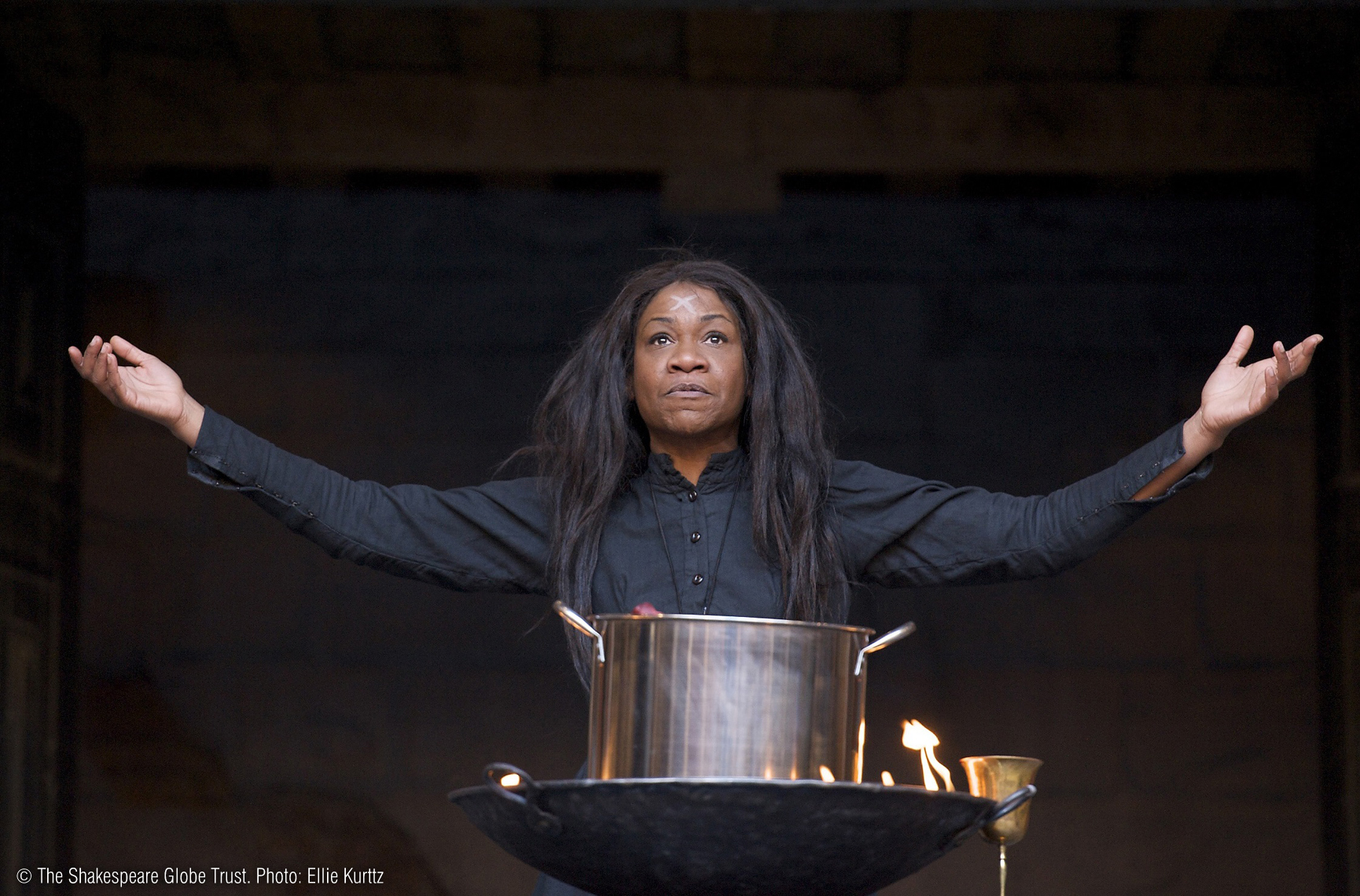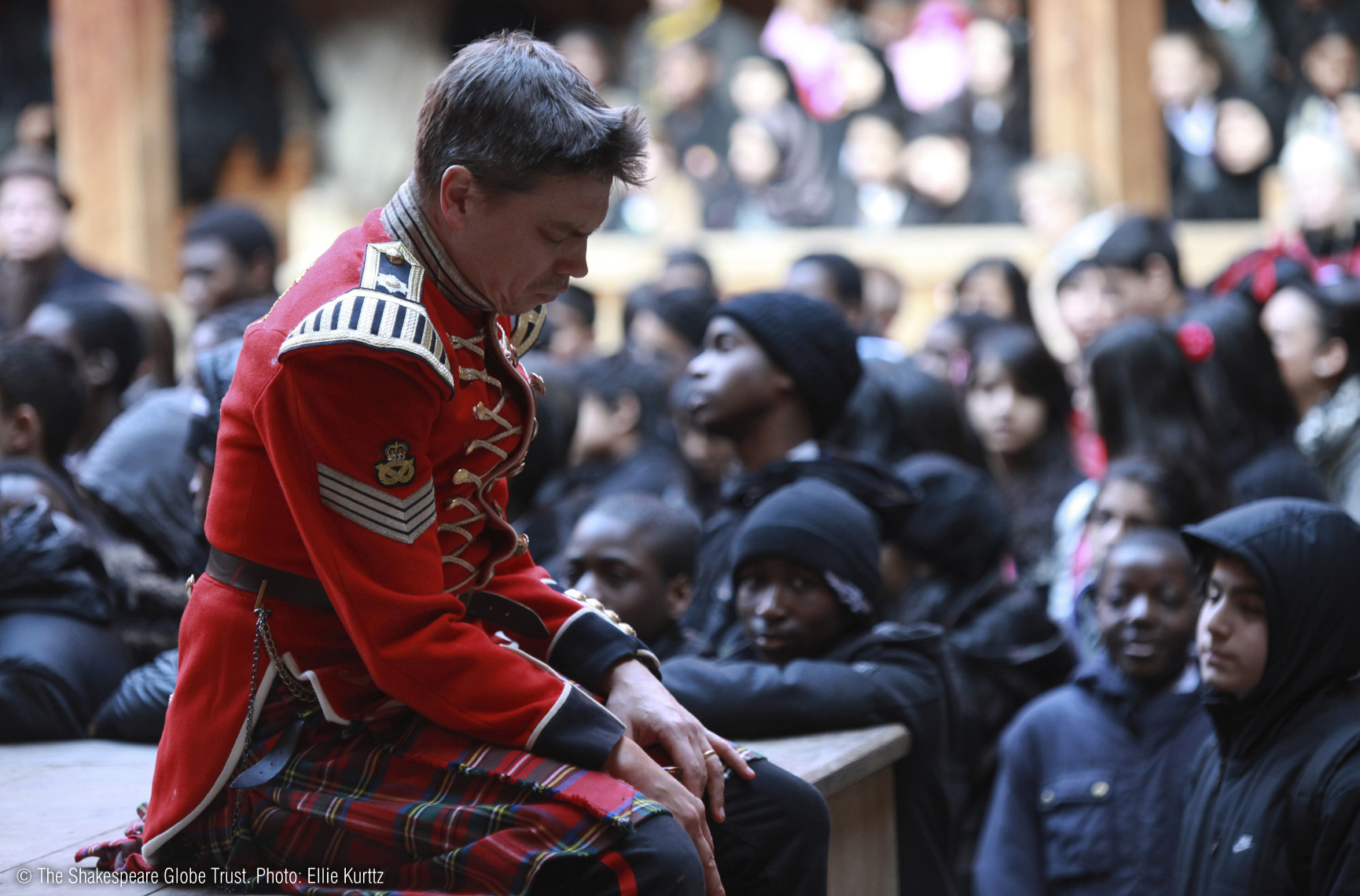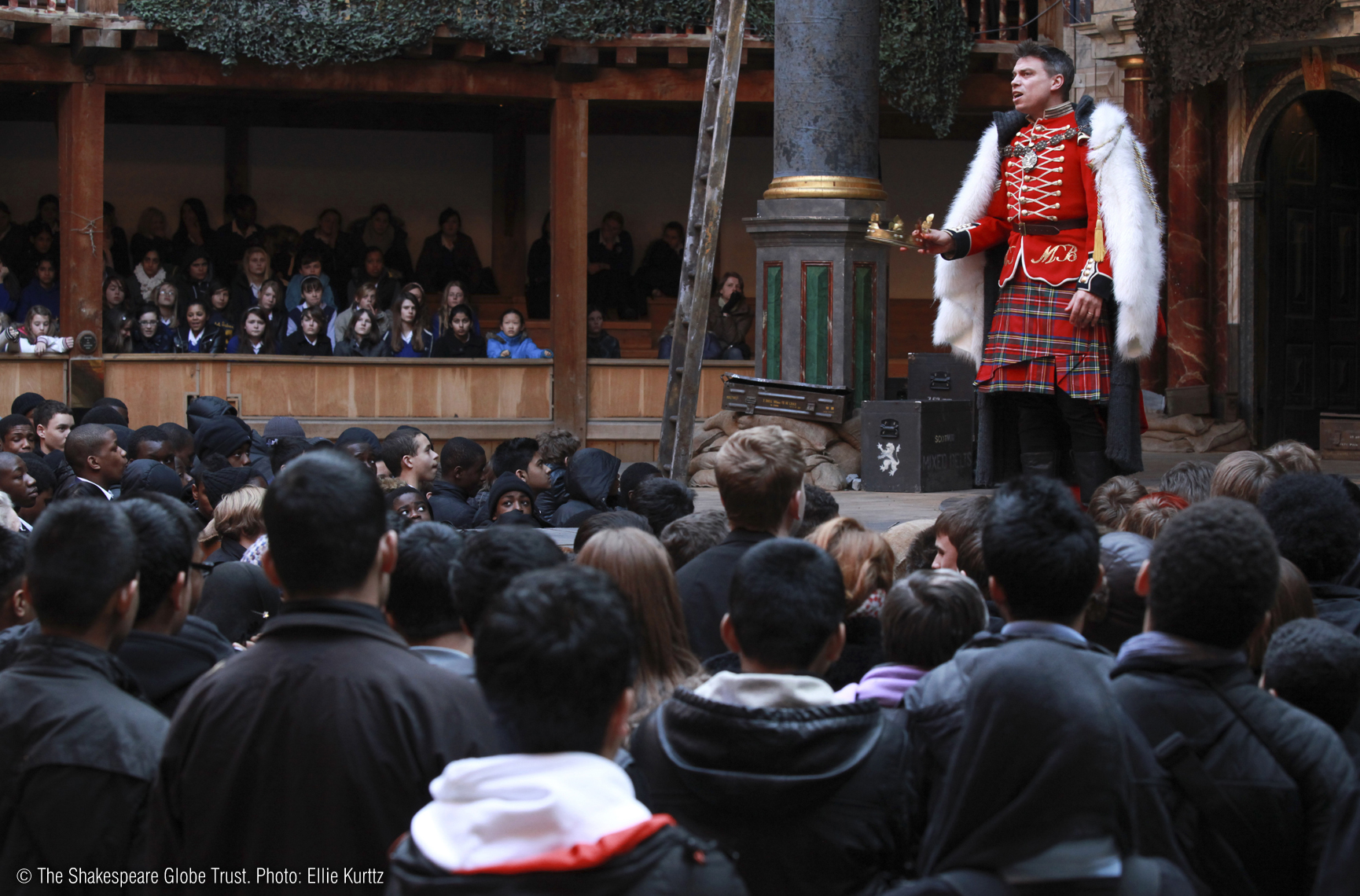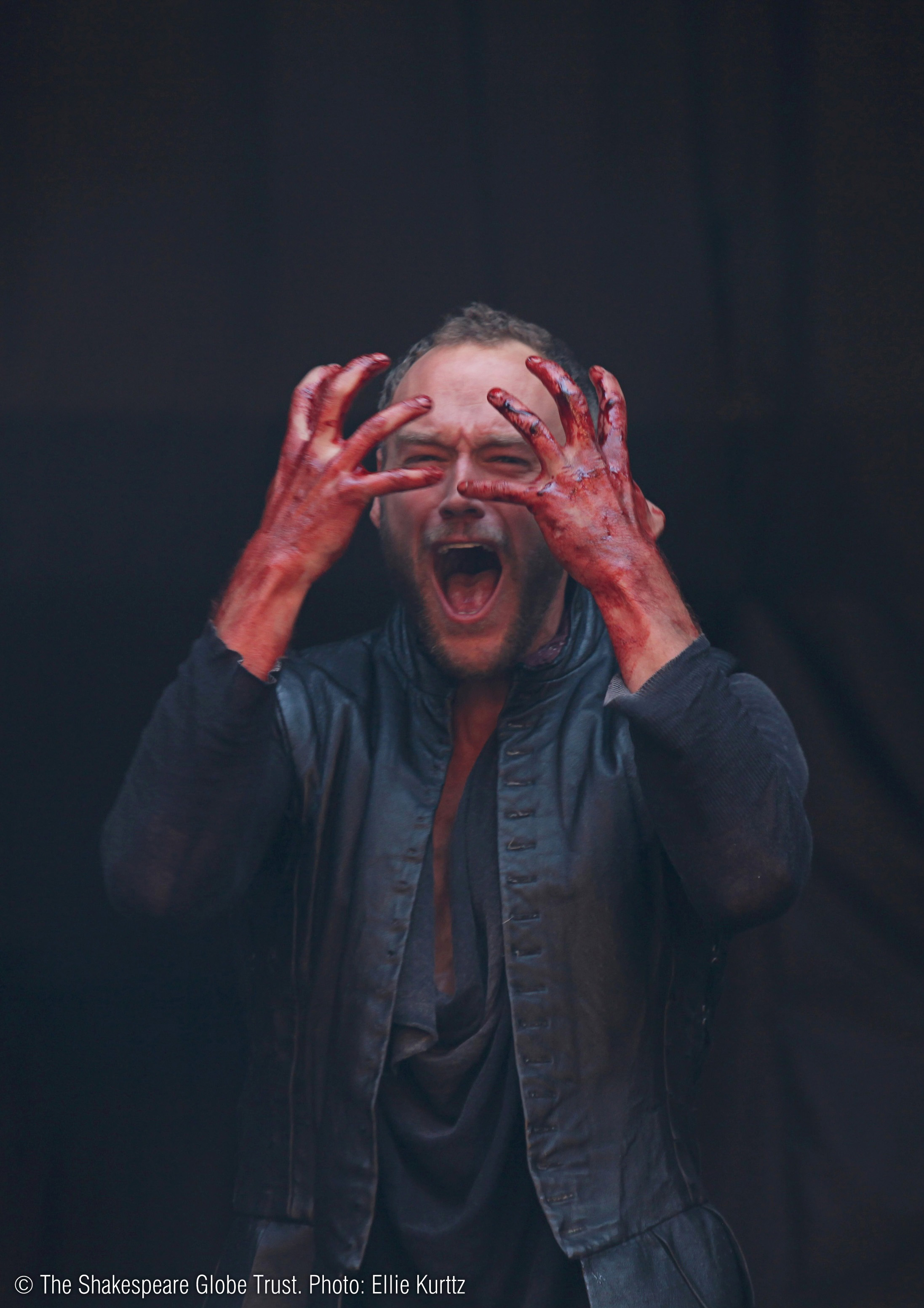In these lessons, students will examine the key characters in Macbeth and their dramatic functions. Tasks include: exploring the motivations of Lady Macbeth; tracking characters' status throughout the play to see how and why this changes; and analysing Macbeth's 'vaulting ambition'.
In order to benefit fully from these lesson plans, we recommend you use them in the following order:
- Text in Performance
- Language
- Characters
- Themes
- Contexts
If students are new to the play, we suggest you start with these introductory KS3 Lesson Plans. If you would like to teach the play in greater detail, use the advanced KS4/5 Lesson Plans.
These lesson plans are available in the Downloads section at the bottom of this page. To download resources, you must be logged in. Sign up for free to access this and other exclusive features. Activities mentioned in these resources are available in a separate downloadable 'Student Booklet', also at the bottom of this page. The 'Teachers' Guide' download explains how best to use Teach Shakespeare and also contains a bibliography and appendices referencing the resources used throughout.
Key Questions for Students:
Can I explore the dramatic function of the witches in Macbeth?
Can I develop my ideas about how the witches could be portrayed on stage?
Key words: alliteration, archetypes, body language, characters, choral speaking, costume, motivation, music, repetition, rhyme, rhythm, riddle, voice
Prologue: Opening Discussion
Give students the first four lines of the play to read in threes.
1 Witch. When shall we three meet again?
In thunder, lightning, or in rain?
2 Witch. When the hurlyburly’s done,
When the battle’s lost and won.
Students can experiment with different ways of performing these lines (e.g. whispering, like a nursery rhyme, forwards and backwards at the same time). How would the different ways of performing these lines affect the audience’s impression of the witches and the overall mood at the start of the play?
Enter the Players: Group Tasks
1) Archetypes
Share Fiona Banks’ character archetypes (sovereign, warrior, carer, trickster), which can be found in the Student Booklet. Work through some ideas for developing students’ understanding of these archetypes, including four lines selected from the play that show how each of the four different archetypes is present in the witches’ language. What insights into the characters of the witches do we gain from these kinds of activities?
2) The witches – different approaches
Prepare and distribute to different groups of students some ‘clues’ about the way the witches were portrayed in a particular production of Macbeth or could be portrayed. These clues could be pictures, images, props, descriptions of performances by audience members etc. Ways they have been played previously include:
- as priestesses
- as seducers
- as drug addicts
- as lost children
- as nurses
- as disembodied voices
Students need to think about the clues (which might be a little bit cryptic!) and what they suggest about performing the witches. Students feedback to the rest of the class with their personal opinions and evaluative comments about how well they think this idea would work on stage.

3) Choral speaking
Students should read and rehearse Act 1 Scene 3, identifying examples of rhyme, rhythm, alliteration, repetition, riddle-like language and other techniques. They should then discuss as a group how to make the witches seem different and otherworldly in their performance of this scene. Students should think about the many different ways they can use their voices in choral speaking (e.g. vary speed, vary pitch, vary volume, speak in unison or at different speeds, vary the number of speakers). How might these decisions affect the audience? (Students could watch some footage of the Witches in Act 1 from the Globe production and reflect on how the Witches speak and are portrayed.)
Exeunt: Closing Questions for Students
What do the witches represent?
What is their dramatic function?
How would I portray the witches if I were staging the play?
Suggested plenary activity…
Students could choose one way of portraying the witches and one idea that would help them to convey this to the audience, e.g. voice effects, costume, movement, lighting. Students should record their answers in the Student Booklet.
Aside: Further Resource
- There is an interesting text about the witches on the Playing Shakespeare with Deutsche Bank microsite for Macbeth at 2011.playingshakespeare.org/themes-and-issues/the-witches
Epilogue: Teacher's Note
Students could research how the witches have been portrayed in a variety of other productions on the stage and in film. An additional task might be for students to compare and give their personal views on two different interpretations, e.g. in the Trevor Nunn version starring Ian McKellen and in the Rupert Goold version starring Patrick Stewart. They should justify their choice.
Key Questions for Students:
Can I explain the dilemmas and decisions facing Macbeth?
Can I analyse Shakespeare’s language to help me understand Macbeth’s thoughts and feelings in some key scenes?
Key words: ambition, debate, decision, dilemma, persuasion, sense unit, speech
Prologue: Opening Discussion
Ask students to think about something they really want – a coveted possession or an ambition that spurs them on. They should think of an image that represents that ‘dream’. Then ask students to discuss in twos or threes what they would do or what they would sacrifice to pursue that dream. Can they think of examples from movies, TV shows, books, etc. where characters did something risky or bad to achieve their goals? The ensuing discussion might cover: moral code; religious principles; consideration for other people’s feelings; fear of being found out; aversion to breaking the law of the land; wanting to do things fair and square, etc.
Now bring the discussion back to Macbeth, what he wants, and what he would have to do to get what he wants.
Enter the Players: Group Tasks
1) Text detectives: who, what, why, how?
Students should read Macbeth’s soliloquy that opens Act 1 Scene 7 (lines 1-28) which is included in the Student Booklet. Students should read the extract in small groups and break the speech into sense units. Then answer the following questions for each sense unit:
- Who am I?
- What am I saying?
- Why am I saying it?
- How do I speak?
Encourage students to be as thoughtful as possible in their answers to question 1. They should go beyond, ‘Well, I’m Macbeth of course’, to thinking about how Macbeth’s different identities reveal themselves: warrior, loyal subject, husband, Christian, etc. Begin by modelling the first part before asking students to continue the close analysis of the passage in question.
2) Internal debate
The following three activities support students in thinking about Macbeth’s decision-making process. They also support thinking about how Shakespeare reveals a character’s thoughts and feelings in the language and structure of his or her speeches. These activities (explained more fully in the Teachers’ Guide for Macbeth) would work well with the passage mentioned above from Act 1 Scene 7 or with the ‘Is this a dagger…?’ speech from Act 2 Scene 1.
- Positive and negative walls: moving in one direction or another to represent the positive and negative thoughts and feelings in a line by line reading and analysis of a speech or soliloquy
- conscience alley: this works particularly well when a character is facing up to a momentous decision
- self-persuasion: looking at how Macbeth presents the arguments to himself
- finding the questions: after a student reads a line, other students find something to question in that line

3) Decision and indecision
Compare the speech from Act 1 Scene 7 about killing the king with Macbeth’s speech in Act 4 Scene 1 (lines 144-156) about killing Macduff’s family, which is also included in the Students Booklet. Draw a simple chart with two columns marked ‘Decisive’ and ‘Indecisive’. Ask students to find examples of language that shows Macbeth being decisive or indecisive and take feedback. Points raised might include:
- Macbeth repeatedly uses ‘If… in Act 1 Scene 7
- Macbeth’s use of ‘it’ and ‘tis’ in Act 1 Scene 7 suggest that he finds it hard to even mention the words ‘kill’ or ‘murder’
- Macbeth sounds impatient to kill in Act 4 Scene 1, e.g. ‘The very firstlings of my heart shall be the firstlings of my hand’ and ‘This deed I’ll do, before this purpose cool’
N.B. Students could try out some role play about real-life situations, which could lead to some beneficial insights in preparation for this text-based activity. In groups of three, two students improvise a scenario in which one student is trying to get the other to make a decision, who is not willing to commit or decide. Then try it again, having rotated roles, so that the student being asked to decide is quick and eager to make a decision. The observer(s) should note down examples of decisive and indecisive language and body language.
Exeunt: Closing Questions for Students
What have I learned about the dilemmas and decisions facing Macbeth in the play?
What has this added to my view of Macbeth?
What motivates Macbeth?
Does my view of this change as the play goes on?
Suggested plenary activity…
On sticky notes, students should write some words, pictures, diagrams, quotations and calligrams showing Macbeth’s thoughts and feelings. Elicit from students some ideas about how Macbeth’s thoughts and feelings change as the play moves on.
Asides: Further Resources
- Students might like to browse Macbeth’s social media profile page at 2011.playingshakespeare.org/character-and-motivation/macbeth. These pages have also been created for many of the play’s other characters.
- Students could watch James Garnon perform the speech from Act 1 Scene 7 in this clip:
Epilogue: Teacher's Note
Work on Act 2 Scene 1 could be linked to further detailed work on this scene in performance in the materials from Key Stage 4/5: Text in Performance.
Key Questions for Students:
Can I describe Lady Macbeth’s character and explain what motivates her?
Can I analyse some of the language she uses to support my views?
Key words: analyse, character, context, motivation, obituary
Enter the Players: Group Tasks
1) Head space
Show students an image of a phrenological chart or model. Explain what it was used for and what it was thought to show.
Ask students in pairs or groups of three to use this image as inspiration for a 2D or 3D image representing Lady Macbeth’s character: her thoughts and feelings, likes and dislikes, hopes and fears, memories and regrets. The more important the thought or feeling, the more space students should give that ‘zone’ on the picture or model. As an extension activity, students could add quotations to support some of their points.
2) Truth and lies
Display Act 1 Scene 6 lines 10-20 (which is in the Student Booklet), along with another short passage from Act 2 Scene 3 lines 79-87:
Passage A:
Duncan: See! See! our honour’d hostess. –
The love that follows us sometime is our trouble,
Which still we thank as love. Herein I teach you,
How you shall bid God ‘ild us for your pains,
And thank us for your trouble.
Lady Macbeth: All our service,
In every point twice done, and then done double,
Were poor and single business, to contend
Against those honours deep and broad, wherewith
Your Majesty loads our house: for those of old,
And the late dignities heap’d up to them,
We rest your hermits.
Passage B:
[Enter Lady Macbeth.]
Lady Macbeth: What’s the business,
That such a hideous trumpet calls to parley
The sleepers of the house? speak, speak!
Macduff: O gentle lady,
‘Tis not for you to hear what I can speak:
The repetition, in a woman’s ear,
Would murther as it fell.
[Enter Banquo]
O Banquo! Banquo!
Our royal master’s murther’d!
Lady M: Woe, alas!
What! in our house?
Banquo: Too cruel anywhere.
Students quickly brainstorm what has happened before this point in the play and then read the scene in pairs. Model a close reading of these lines for students, demonstrating an understanding that what Lady Macbeth says and what we the audience know she really thinks are very different indeed. Model filling in the handout with a piece of evidence (a word or very short phrase) and a brief comment. Then repeat with Passage B, but this time support students to choose a word or phrase themselves and then record their own comment about it. (Students could watch Act 2 Scene 3 from the production starring Emma Pallant as Lady Macbeth.)
3) Lady Macbeth’s obituary
Macbeth receives the news that Lady Macbeth has died in Act 5 Scene 5. Students could write a short obituary in their Student Booklet for Lady Macbeth using a text such as this one as a model: auspostalhistory.com/articles/1935
A suitable structure might be:
- a simple title and a longer sub-title (perhaps using a quotation from the play here)
- an opening paragraph informing readers of her death and describing her early life
- a middle paragraph that goes into more detail about her later life and mentions any family that survive her
- a short final paragraph about funeral arrangements/where she has been buried
Exeunt: Closing Questions for Students
What do we learn about Lady Macbeth as the play progresses?
What are her strengths and weaknesses?
Is she responsible for her own and her husband’s downfall?
Suggested plenary activity…
Students should choose one of the points they have made about Lady Macbeth and find a suitable quotation to support it.
Asides: Further Resources
- Lady Macbeth’s social media page can be found on the Playing Shakespeare with Deutsche Bank microsite at 2011.playingshakespeare.org/character-and-motivation
- Which word is missing from each of these Lady Macbeth quotations? This task is available in the Student Booklet.
- ‘The raven himself is hoarse,
-
That croaks the _______ entrance of Duncan.’
- ‘And fill me, from the crown to the toe, top-full/Of
- ‘…I feel now/The ________ in the instant.’
- ‘When you durst do it, then you were a _____.’
- ‘That which hath made them drunk hath made me ________’
- ‘Had he not resembled
-
My _________ as he slept, I had done’t.’
- ‘A _________ thought to say a sorry sight.’
- ‘Stand not upon the ________ of your going…’
- ‘Yet who would have thought the old man to have had so much ________ in him?’
- ‘What, will these _______ ne’er be clean?’
blood bold cruelty hands fatal
father foolish future man order
Epilogue: Teacher's Note
A useful activity to link to can be found in the Text in Performance section of these materials. In the activity, students sort and analyse cards showing images of Lady Macbeth from different Globe productions of Macbeth.
Key Questions for Students:
Can I establish the status of the characters in Macbeth in relation to each other, and how this changes throughout the play?
Can I identify different ways in which status is shown on stage?
Key words: archetype, assassination, hierarchy, kingship, power, speech, status
Prologue: Opening Discussion
Begin by asking students what status means to them and derive from students a working definition of the word ‘status’. Surround the word with some synonyms and other connected words, e.g. power, rank, position, hierarchy, chain of command. Allocate to students different contexts and ask them to draw a diagram to show the different roles people play within that context and their status in relation to each other. Contexts could include: a school; a hospital; a family; a chain of shops; an army; a youth group, such as a Scout troop; a state; a film studio; a fashion house. What matters is to choose contexts that will be interesting and meaningful to the class.
Enter the Players: Group Tasks
1) Status
Fiona Banks describes a selection of status games in Creative Shakespeare. This game, involving a pack of playing cards, will support students understanding of rank and status in the play. This can lead effectively to discussions about themes such as order/disorder and Macbeth’s ‘vaulting ambition’.
Explain that high numbers from the pack of cards denote high status, whereas a low number such as an ace denotes low status. Students will be given a playing card and should hold it to their head without looking at it. They will walk around the room for a few minutes and see how other students react to them. Finally, students should line up according to what they think their status is and then check to see the number on their card. Draw out in the ensuing discussion how status can be shown on stage. Emphasise that as well as being about someone’s title, appearance, how they speak, behave, etc., it is also shown by how others react to and behave around them.
2) A change in status
Turn to the Dramatis Personae page in the Student Booklet. Ask pairs of students to create diagrams to illustrate the status/social class of the various characters and how this changes over the course of the play. Share observations in a whole class discussion.

3) Duncan’s funeral
Students could work in groups, each named after a different character who would be attending Duncan’s funeral on the island of Iona. The groups should plan the speeches that their characters will deliver at the funeral and record these in their Student Booklet. Success criteria for the speeches might include:
- three points that praise Duncan’s good qualities
- personal anecdote(s)
- reasonably formal tone
Show an image of Iona as a backdrop for the scene. Characters should include: Macduff, Macbeth, Lady Macbeth, Banquo and Fleance, and could include representatives for Malcolm and Donalbain who have already fled. Each group should select one student from the group to deliver the speech at the funeral which you or another student could officiate. Then show a different backdrop and imagine that the characters are at a party in Duncan’s honour and each is speaking their mind about how they really feel at this point in the play. Groups should be given a few minutes to prepare questions, before each character in turn takes the hot-seat to face these questions.
Exeunt: Closing Questions for Students
What different kinds of power do characters have over each other in Macbeth?
How does this change?
How could this be shown on stage?
Suggested plenary activity…
Students fill in a simple grid with four boxes: movement and body language; music; voice; costume.

Students choose a character at a particular point in the play and think about how their status could be shown using these elements of stagecraft, making notes in the boxes. Choose a few students to feedback.
Aside: Further Resource
- Social media pages for the various characters can be found on the Playing Shakespeare with Deutsche Bank microsite at 2011.playingshakespeare.org/character-and-motivation.
Epilogue: Teacher's Note
The speeches task for activity 3 could be assessed for writing.
Key Questions for Students:
Can I comment on whether the audience would view certain characters as heroes or villains and why?
Can I comment on characters’ good and bad points and on what makes a character complex?
Key words: character, characterisation, empathy, hero, vice, villain, virtue
Prologue: Opening Discussion
Students could draw a line about 20cm long and put at one end ‘Character I like most’ and at the other end ‘Character I like least’. Students should arrange as many characters from Macbeth along the line as possible, and be ready to justify their choices in a discussion. Students could then repeat this exercise with ‘Character I’d most like to play’ at one end of the line and ‘Character I’d least like to play’ at the other end. Take feedback, encouraging students to consider the differences between their two diagrams.
Enter the Players: Group Tasks
1) Heroes and villains
In pairs, one student chooses a hero or superhero from a story, film or TV show, and the other student chooses a villain. Both should brainstorm some of the characteristics of those characters. They should share their ideas first with each other, and then in a whole class feedback session. Leading the discussion, you should plot words on two distinct sections of a board or flipchart. Now ask students to think about characters from the play and whether they belong in the hero or villain section of the board or somewhere in between. Discuss findings.
2) Vices and virtues
Leading on from the previous activity, suggest that Shakespeare tends to present his characters as a more believable, interesting and complex mixture of good and bad. Students should take the character outline handout in the Student Booklet and choose any one of the characters from the ‘Heroes and Villains’ activity. This time, they should be exploring the characters’ vices and virtues, using the character outline to present points that emphasise that character’s good and bad points.

3) Challenging roles
In the Student Booklet, there is a page called Challenging Roles. This can be used as a note-taking and planning page for a piece of writing about taking on a challenging Shakespearean role. Students can choose any character from the play and the aim is:
- to write from the point of view of an actor preparing to play that part
- to write a short introduction describing this character and some of the different things they do in the play
- to draw attention to contrasting aspects of the character
- to include some quotations to support main points
Exeunt: Closing Questions for Students
What are the good and bad points about my chosen character?
Has Shakespeare created a believable character?
Can I identify or empathise with my chosen character in any way?
Suggested plenary activity…
Self or peer assess work in progress for Challenging Roles.
Aside: Further Resource
- Social media pages for the various characters can be found on the Playing Shakespeare with Deutsche Bank microsite at 2011.playingshakespeare.org/character-and-motivation.
Epilogue: Teacher's Note
The ‘Challenging roles’ activity in the Student Booklet could be assessed for reading and writing.
